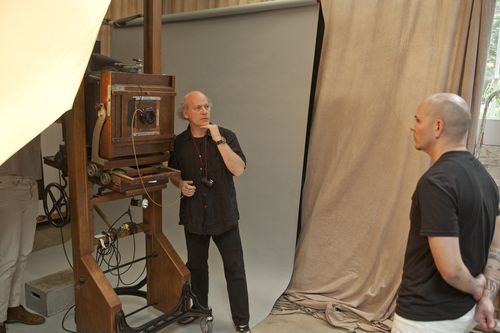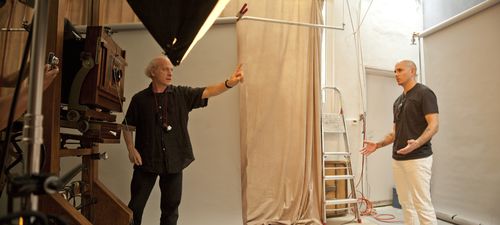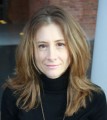Behind the Scenes on The Latino List
If you’ve visited The Latino List exhibition, you may have wondered how Timothy Greenfield-Sanders creates such monumental photographs. It all starts with the camera. For over 30 years Greenfield-Sanders’s signature tools have been the large-format camera and the large-format negatives it produces. Essentially unchanged since its introduction in the late 19th-century, large-format cameras and negatives allow photographers to make extremely large prints with incredible detail and resolution, far beyond what can be currently achieved with digitally originated images.

Greenfield-Sanders turned to a beautiful wooden 8” x 10” Deardorff view camera from the 1930s, fitted with a modern lens, which he used to shoot The Latino List.
In 1978, Greenfield-Sanders started shooting with an antique 11” x 14” view camera. Film for that format was discontinued around 2000 and Greenfield-Sanders turned to a beautiful wooden 8” x 10” Deardorff view camera from the 1930s, fitted with a modern lens, which he used to shoot The Latino List. The technical procedure, which weds vintage apparatus to modern technology, is relatively straightforward: first, he loads the camera with 8” x 10” color negative film—one plate at a time—and, from the only six or so shots captured in the sitting, he selects the negative he wants to print. Using a drum scanner, he generates a 600 MB scan file from the negative, which is digitally cleaned up only for dirt and spots. The scan is then printed on 44 inch wide Epson UltraSmooth paper, retaining the characteristic black borders and notches on the upper left edge that denote the 8” x 10” format.

Greenfield-Sanders on the Latino List set with Pitbull.
Greenfield-Sanders loves the look and feel of large-format photography, particularly how the technique’s typically shallow depth of field focuses attention on the sitter’s face, fostering a sense of stillness, as well as the directness and intimacy that he seeks to capture in his portraits. Apart from its technical capabilities, the physical camera itself plays an important role in Greenfield-Sanders’s work as a portraitist. Sitters are intrigued or amused by the imposing antique camera—some have asked if it belonged to (19th-century photographer) Matthew Brady! Greenfield-Sanders finds that this curiosity about the object, with its rich historical presence, goes a long way toward dissipating any tension even celebrities might feel while having their portrait taken. So too does the fact that, unlike other photographers whose faces remain semi-hidden behind the camera, Greenfield-Sanders stands next to his. Once the shot is framed, photographer and subject can talk face to face and develop a relaxed and personal connection, creating the mood for the right picture to happen.

Lisa Small joined the Brooklyn Museum in Spring 2011 as Curator of Exhibitions. From 2007 until 2011 she was Curator of Exhibitions at the American Federation of Arts (AFA), coordinating traveling exhibitions such as Turner to Cézanne: Masterpieces from the Davies Collection, National Museum Wales, and Gods and Heroes: Masterpieces from the École des Beaux-Arts, Paris. Prior to joining the AFA, Small was a curator at the Dahesh Museum of Art, where she organized numerous exhibitions, including Napoleon on the Nile: Soldiers, Artists, and the Rediscovery of Egypt and Fantasy & Faith: The Art of Gustave Doré. Small has taught art history at Hunter College and Brooklyn College and has been a member of the art history faculty at the School of Visual Arts since 2008. Small earned a B.A. from Colgate University, an M.A. and an M.Phil in Art History from CUNY, and an M.A. in Arts Administration from NYU.
